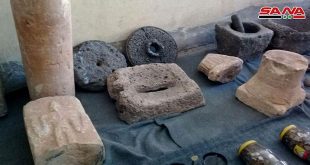Damascus, SANA – The Trojan War between the Greeks and Trojans, is one of the most famous mythological epics, featuring memorable heroes and fantastical events that continue to inspire people to this day. These heroes and events were the subjects that an anonymous Syrian artist who had lived during the second century AD chose to carve on a sarcophagus.
According to scholar Nasr Flehan, the sarcophagus, which is on display at the National Museum in Damascus, was found in 1977 at al-Rastan city inside a house. It is 70 cm deep, 220 cm long, and 100 cm wide.
Flehan said the sarcophagus is an example of the interaction between eastern and western art, and that it features four scenes from the epic tale as described by Greek poet Homer, with the center featuring the Greek champion Achilles killing Hector, the champion and prince of Troy and brother to Paris who had kidnapped Helen, thereby causing the war between the Greeks and the Trojans.
The sarcophagus also features King Agamemnon, the leader of the Greek campaign, in his ship, and in the left corner is Poseidon, the god of the sea, and his wife, Amphitrite, each of them holding a sea serpent, while on the right corner is Artemis, the goddess of the hunt.
Many archeological finds have been uncovered in al-Rastan city which dates back to the second millennium BC, according to text of Hatha, and was named Arethusa, with the city persisting throughout the Aramaic, Seleucid, Hellenistic, Roman, Byzantine, and Islamic periods.
Hybah Sleman / Hazem Sabbagh
 Syrian Arab News Agency S A N A
Syrian Arab News Agency S A N A




